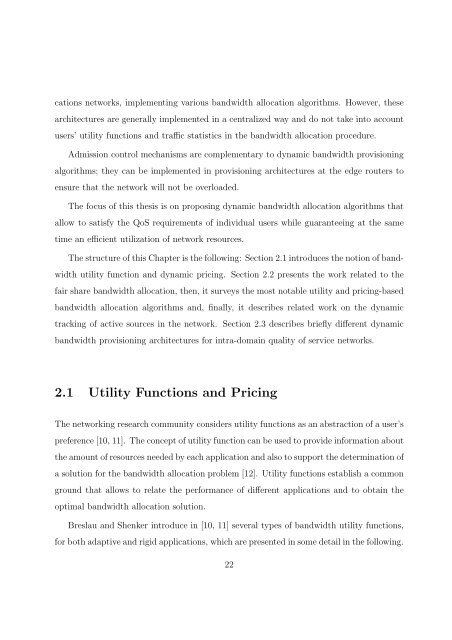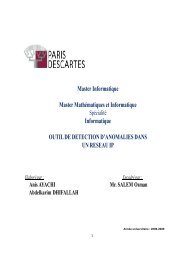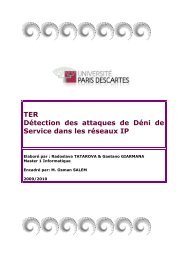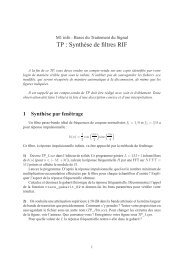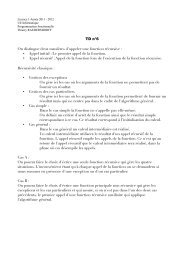Th`ese de Doctorat de l'université Paris VI Pierre et Marie Curie Mlle ...
Th`ese de Doctorat de l'université Paris VI Pierre et Marie Curie Mlle ...
Th`ese de Doctorat de l'université Paris VI Pierre et Marie Curie Mlle ...
You also want an ePaper? Increase the reach of your titles
YUMPU automatically turns print PDFs into web optimized ePapers that Google loves.
cations n<strong>et</strong>works, implementing various bandwidth allocation algorithms. However, these<br />
architectures are generally implemented in a centralized way and do not take into account<br />
users’ utility functions and traffic statistics in the bandwidth allocation procedure.<br />
Admission control mechanisms are complementary to dynamic bandwidth provisioning<br />
algorithms; they can be implemented in provisioning architectures at the edge routers to<br />
ensure that the n<strong>et</strong>work will not be overloa<strong>de</strong>d.<br />
The focus of this thesis is on proposing dynamic bandwidth allocation algorithms that<br />
allow to satisfy the QoS requirements of individual users while guaranteeing at the same<br />
time an efficient utilization of n<strong>et</strong>work resources.<br />
The structure of this Chapter is the following: Section 2.1 introduces the notion of band-<br />
width utility function and dynamic pricing. Section 2.2 presents the work related to the<br />
fair share bandwidth allocation, then, it surveys the most notable utility and pricing-based<br />
bandwidth allocation algorithms and, finally, it <strong>de</strong>scribes related work on the dynamic<br />
tracking of active sources in the n<strong>et</strong>work. Section 2.3 <strong>de</strong>scribes briefly different dynamic<br />
bandwidth provisioning architectures for intra-domain quality of service n<strong>et</strong>works.<br />
2.1 Utility Functions and Pricing<br />
The n<strong>et</strong>working research community consi<strong>de</strong>rs utility functions as an abstraction of a user’s<br />
preference [10, 11]. The concept of utility function can be used to provi<strong>de</strong> information about<br />
the amount of resources nee<strong>de</strong>d by each application and also to support the <strong>de</strong>termination of<br />
a solution for the bandwidth allocation problem [12]. Utility functions establish a common<br />
ground that allows to relate the performance of different applications and to obtain the<br />
optimal bandwidth allocation solution.<br />
Breslau and Shenker introduce in [10, 11] several types of bandwidth utility functions,<br />
for both adaptive and rigid applications, which are presented in some <strong>de</strong>tail in the following.<br />
22


